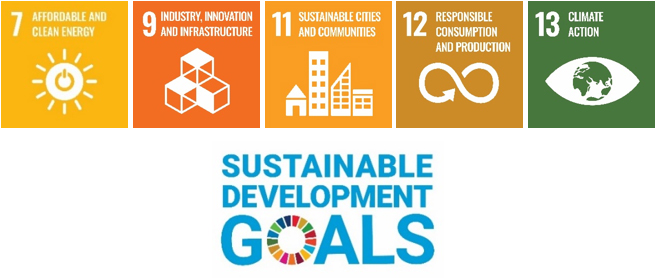Mitsui Fudosan and Tokyo Gas Develop a New Energy Base
” Yaesu Energy Center” to Improve Disaster Preparedness and Environmental Friendliness of Tokyo Station Yaesu Area
- Supply to Tokyo Midtown Yaesu and Yaesu Shopping Mall to commence in the fall -
August 1, 2022
Mitsui Fudosan Co., Ltd.
Tokyo Gas Co., Ltd.
Outlines of the Yaesu Smart Energy Project
- Smart energy project in the Yaesu area in front of Tokyo Station
- Supply energy (power and heat) by the independent distributed energy system to Tokyo Midtown Yaesu, and Yaesu Shopping Mall, an underground shopping mall having the largest sales floor space in Tokyo, located in front of the Yaesu exit of Tokyo Station which is a major transport hub of Japan.
- Contribute to neighborhood creation with high international competitiveness by strengthening disaster preparedness and environmental friendliness
- Improves disaster preparedness through high energy resilience
- Contribute to the business continuity of companies during a natural disaster or emergency by providing stable supply of energy through medium-pressure city gas pipelines with strong earthquake resistance, and multiplexing power sources through a large CGS*1 powered by medium-pressure city gas and grid power.
- Contribute to disaster preparedness of the community through the supply of power and heat to public facilities such as bus terminal, elementary school and emergency shelters, etc.
- Contribute to resolving power shortages when the power supply is under pressure
- Contribute to reduce energy usage and CO2 emissions through local production for local consumption
- Reduce CO2 emissions by approximately 26.0% compared to an ordinary building thanks to the efficient use of waste heat from the CGS power generation and the adoption of high-efficiency equipment, as well as the optimal operation of equipment through an energy management system (EMS) that uses information and communications technology (ICT).
- Contribute to companies’ RE100 initiatives by substantially power greening using non-fossil fuel energy certificates with tracking.
- 1 Abbreviation of cogeneration system. This produces power and heat onsite from a heat source such as city gas, and supplies energy with a high total energy efficiency.
Tokyo, Japan, August 1, 2022, Mitsui Fudosan Co., Ltd. (“Mitsui Fudosan”) and Tokyo Gas Co., Ltd. (“Tokyo Gas”) announced today that Mitsuifudosan TG Smart Energy Co., Ltd. (“Mitsuifudosan TG Smart Energy”), a company they jointly established, completed the construction of the Yaesu Energy Center on July 31. From September 1, 2022, the Center will start supplying power and heat to Tokyo Midtown Yaesu and Yaesu Shopping Mall, marking the start of the Yaesu Smart Energy Project (the “Project”).
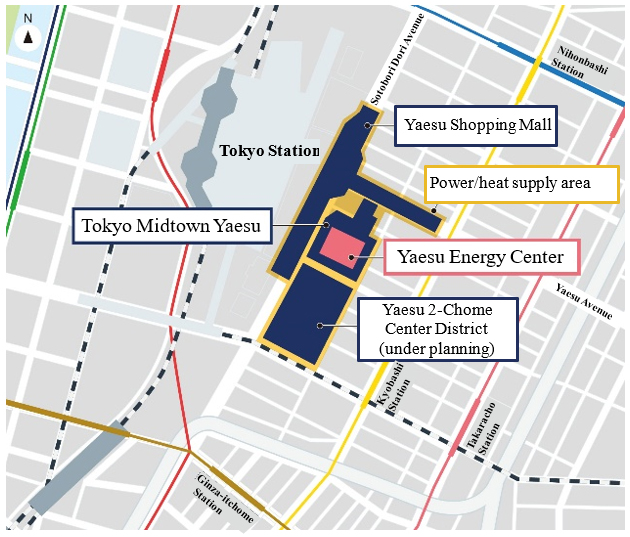
Supply area
■Features of the Project
The Project is the third project of its kind, following on from Mitsuifudosan TG Smart Energy’s Nihonbashi Smart Energy Project which began the supply of power and heat in April 2019, and the Toyosu Smart Energy Project which began the supply of power and heat in April 2020. The initiative aims to improve the international competitiveness of Yaesu, an important transport and economic hub of Japan, by supplying energy from the independent distributed energy system to the Yaesu area in front of Tokyo Station. The project contributes to the improvement of disaster preparedness and environmental friendliness of the overall neighborhood. The supplied area includes Tokyo Midtown Yaesu, a large-scale mixed-use*2 redevelopment project comprising offices, stores, a hotel, a bus terminal, an elementary school, as well as the existing Yaesu Shopping Mall, an underground shopping mall having the largest sales floor space in Tokyo. The Project will also supply energy to the Yaesu 2-Chome Center District Category-I Urban Redevelopment Project currently being built in the neighboring district once it is completed.
Mitsui Fudosan and Tokyo Gas will continue to deliver resilient and eco-friendly neighborhood creation projects through smart energy projects considering the characteristics of the area and the development of the neighborhood.
- 2 One building, area, etc. having multiple uses such as residential, retail, office and cultural facilities.
(1) Smart energy project in the Yaesu area in front of Tokyo Station
The opening of Tokyo Station in 1914 and the Yaesu exit in 1929 created Yaesu as a gathering place for corporations and business from the regions and the “heart of the Japanese economy”. Leading Japanese corporations chose Yaesu as their base to start business in Tokyo, making the area a launch pad for both domestic and international business activities. The Yaesu area is also the “gateway to Japan”, being a major transport hub, with the Shinkansen connecting to the entire nation, as well as railways, subways and bus terminals, meaning disaster preparedness and environmental friendliness is a key issue. The Project contributes to the international competitiveness of the Yaesu area by providing an independent distributed energy system built around the CGS within the Tokyo Midtown Yaesu in front of Tokyo Station to maintain the energy supply to the Yaesu area in an emergency, as well as reduce CO2 emissions in normal times through efficient equipment operation using the latest ICT.

Energy flow diagram
(2) Improves disaster preparedness of the neighborhood through high energy resilience
The Project seeks to improve the disaster preparedness of the neighborhood
- Capable of meeting the power and heat supply required (50.0% of annual peak level) for BCP*3 during emergencies
The Project introduces a large CGS powered by medium-pressure city gas, with the CGS capable of supplying power during a grid power outage as long as the medium-pressure city gas supply continues. If the water supply is cut, the supply of heat will also be maintained by making effective use of water in the heat storage tank as a coolant for heat source facilities. The Project also improves the disaster preparedness of the city including the neighboring areas. In an emergency, power and heat will also continue to be supplied to Chuo Municipal Joto Elementary School, the center of neighborhood disaster response facilities, as well as public facilities such as the bus terminal and emergency shelters, etc. for stranded people. The supply of power to the bus terminal is expected to play an important role in an emergency by being enables the use of buses to transport stranded people.- 3 Abbreviation of business continuity plan. A plan for the business continuity of a company.
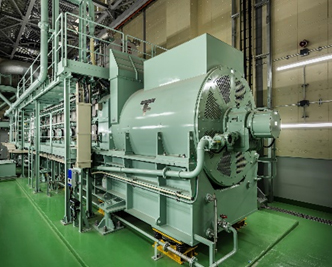
CGS image - City gas supply from highly reliable medium-pressure city gas pipelines in an emergency
The medium-pressure city gas pipes that power the CGS are made of welded steel pipes that offer excellent strength and flexibility needed to withstand ground deformation. Moreover, the medium-pressure gas pipelines have looped supply routes to ensure high supply stability. - Energy plant disaster preparedness measures
The energy plant in the Project is located underground, to be less impacted by earthquakes, and has been built with a structure to withstand tremors. The energy plant uses an urceolate submarine structure comprising of walls between the fourth basement floor and the second floor to prevent water entering the energy plant in the event of flooding. Protecting the energy plant from disasters allows it to maintain energy supply in an emergency. - Contribute to resolving power shortages when power supply is under pressure
The power supply is expected to come under pressure in the summer and winter when the power demand rises. The Project reduces the load on the power grid during normal times through the power generation by the CGS which is an independent distributed energy resource, contributing to the stabilization of the power demand and supply. On a request from the power grid when the power supply is under pressure, the CGS can provide power to the Yaesu area and then share spare power with the power grid, easing the pressure on the power supply.
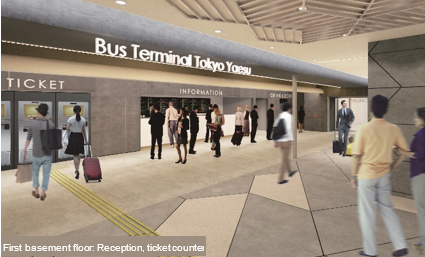
Bus Terminal Tokyo Yaesu (CG)
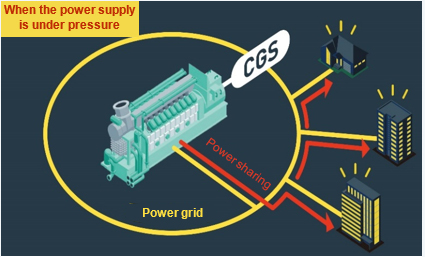
Contribute to easing of the pressure on power supply
(3) Contribute to reduce energy usage and CO2 emissions through local production for local consumption
The CGS introduced as part of the Project is highly resilient, and reduces energy usage through its high energy efficiency (power generation efficiency of 48.5%*5, total energy efficiency including waste heat usage of 77.0%) compared to a normal thermal power plant’s power generation efficiency of approximately 40.0% *4. The energy saving structure including the CGS reduces CO2 emissions by approximately 26.0% compared to an ordinary building.
< Energy saving structure >
- Use the CGS to efficiently generate power, as well as supply heat through the effective use of waste heat from power generation
- Build EMS using ICT to plan and control efficient operation for the entire neighborhood
The energy demand for the following day is estimated by using cutting-edge ICT technology and analyzing big data accumulated on historical energy demand performance, weather forecasts, schedules, and other information. The optimal operation of heat source facilities including the CGS considering the energy demand helps efficient energy supply.
- 4 Based on the power primary energy conversion factor according to the Act on the Rational Use of Energy.
- 5 Based on the manufacturer catalogue figure.
The supplied power will be added the environmental value of the five nationwide solar power plants owned and developed by Mitsui Fudosan as “Non-fossil Fuel Energy Certificates with Tracking”. This achieves the greening of used power by effectively supplying power as renewable energy.
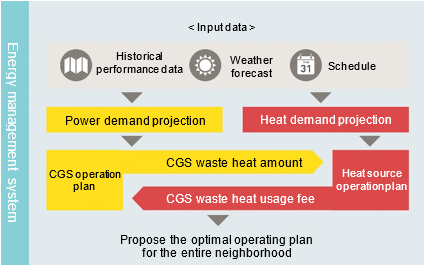
EMS conceptual diagram
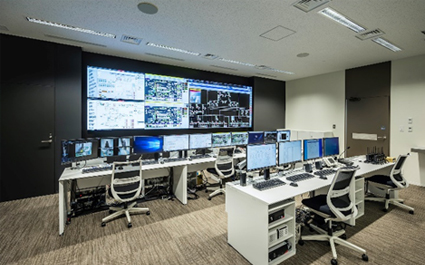
Central control room EMS image diagram
■Energy center outline
| Scheduled supply start date | September 1, 2022 |
|---|---|
| Installation location | 2-1 Yaesu 2-chome, Chuo-ku, Tokyo |
| Energy center total floor area | Approximately 12,300m2 |
| Energy Supplied area | Approximately 18,000m2 |
| Energy Supplied area total floor area | Approximately 350,000m2 |
| Scheduled energy supply capacity | Power: 21,600kW Cool heat: Approximately 120GJ/h Warm heat: Approximately 105GJ/h |
| Main equipment | Gas engines 7,800kW x 2 units Waste gas boilers 4t/h x 2 units Steam absorption chillers with exhaust heat recovery 1,500RT x 2 units Steam absorption chillers 900RT x 1 unit Centrifugal chillers 1,300RT x 3 units Steam boilers 3t/h x 8 units (single fuel-fired, gas), 2t/h x 4 units (dual-fuel fired, gas and oil) |
■Mitsui Fudosan Group’s contribution to SDGs
https://www.mitsuifudosan.co.jp/english/esg_csr/
The Mitsui Fudosan Group aims for a society that enriches both people and the planet under the principles of coexist in harmony with society, link diverse values and achieve a sustainable society, and advances business with an awareness of the environment (E), society (S) and governance (G), thus promoting ESG management. By further accelerating its ESG management, the Group will realize Society 5.0, which the Japanese government has been advocating, and contribute significantly to achieving the SDGs. Additionally, the Group formulated the following Group guidelines related to “Realize a Decarbonized Society” and “Diversity & Inclusion Promotion” in November 2021. The Mitsui Fudosan Group will continue to work toward solving social issues through neighborhood creation.
References
Group Action Plan to Realize a Decarbonized Society
https://www.mitsuifudosan.co.jp/english/corporate/news/2021/1124/
Diversity & Inclusion Promotion Declaration and Initiative Policy
https://www.mitsuifudosan.co.jp/english/corporate/news/2021/1129_02/
■Tokyo Gas Group’s contribution to SDGs
Since its founding, Tokyo Gas has been working through its business to solve social issue such as environmental problems, and to address social priorities such as maintaining and improving stable supply of energy and energy security. Japan’s Fundamental Plan for National Resilience calls for energy resilience. As part of its efforts to strengthen disaster preparedness, Tokyo Gas has prepared a supply network for city gas that will successfully ensure a stable energy supply even in the event of an earthquake comparable to the Great East Japan Earthquake. In addition, Tokyo Gas has also introduced CGS which is an independent distributed energy resource. It has been involved in initiatives regarding the effective use of energy as a local energy supplier for approximately half a century and aims to realize cities with enhanced energy resilience that are in harmony with the environment. In the Tokyo Gas Group Management Vision Compass 2030, Tokyo Gas has adopted “Enhanced resilience functions through the use of natural gas” as one of its key actions for realizing a sustainable society. Accordingly, Tokyo Gas is striving to expand distributed energy systems in an effort to create disaster resilient daily lifestyles and neighborhoods where energy can be continuously supplied even during emergencies.
The Project aims to transform the Yaesu area into an environmentally friendly, disaster resilient neighborhood. To do so, Mitsuifudosan TG Smart Energy has set up an energy center with a CGS as the main facility to provide local production of power and heat for local consumption. In this manner, the Project will contribute to the achievement of the SDGs, which seek to realize a sustainable society by ensuring safe and secure cities and reducing environmental impact.
The Project contributes to the progression towards the five following goals.
| Goal 7 | Affordable and Clean Energy |
|---|---|
| Goal 9 | Industry, Innovation and Infrastructure |
| Goal 11 | Sustainable Cities and Communities |
| Goal 12 | Responsible Consumption and Production |
| Goal 13 | Climate Action |
